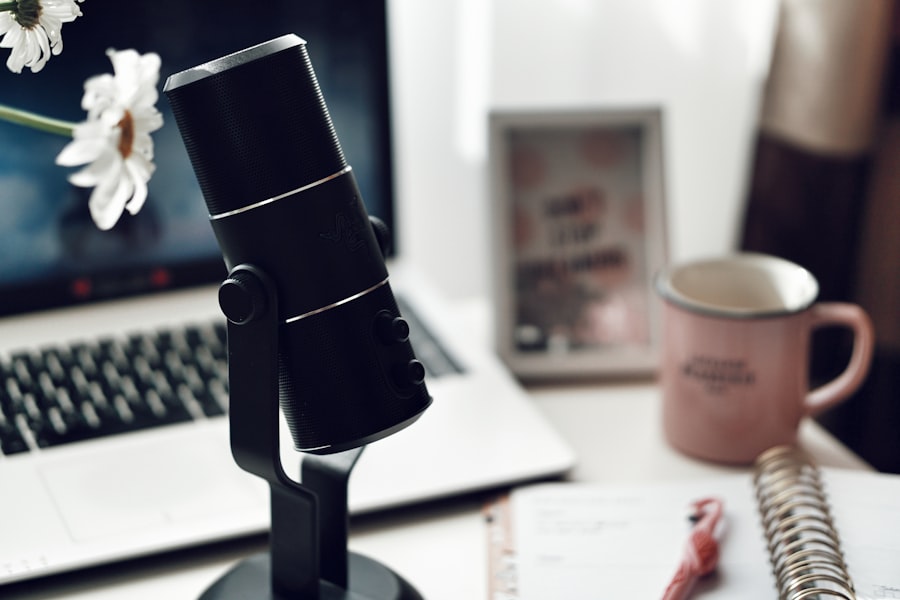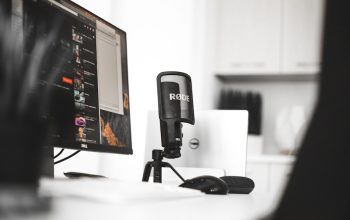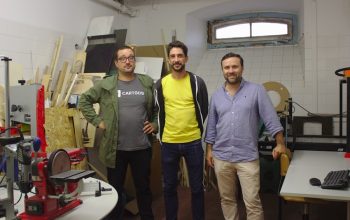Selecting the right microphone is a critical step in establishing a successful podcast. The microphone serves as the primary tool for capturing your voice, and its quality can significantly influence the overall sound of your recordings. There are several types of microphones available, each with its unique characteristics.
Dynamic microphones, for instance, are robust and handle high sound pressure levels well, making them ideal for loud environments. They are often favored by podcasters who record in less-than-ideal acoustic settings, as they tend to pick up less background noise. On the other hand, condenser microphones are more sensitive and can capture a broader frequency range, which is beneficial for nuanced vocal performances.
However, they require a quieter recording environment to avoid picking up unwanted sounds. When choosing a microphone, it’s essential to consider your recording environment and the type of content you plan to produce. For instance, if you’re recording in a home studio with controlled acoustics, a condenser microphone might be the best choice for its clarity and detail.
Conversely, if you’re recording in a bustling café or a noisy room, a dynamic microphone could be more suitable due to its ability to reject ambient noise. Additionally, some microphones come with built-in features like USB connectivity, which simplifies the recording process by allowing direct connection to a computer without the need for additional equipment. Ultimately, the right microphone will depend on your specific needs, budget, and the sound quality you wish to achieve.
Key Takeaways
- Choose a microphone that suits your recording environment and budget for optimal sound quality.
- Headphones are essential for monitoring audio and ensuring a high-quality recording.
- An audio interface is necessary to connect your microphone to your computer and improve sound quality.
- Research and test different recording software to find the best program for your podcasting needs.
- Pop filters and shock mounts can significantly improve the quality of your audio recordings.
Headphones: Why They Are Essential for Podcasting
Headphones play an indispensable role in the podcasting process, serving as both a monitoring tool and a means of ensuring audio quality during recording and editing. When recording a podcast, wearing headphones allows you to hear exactly what is being captured by the microphone in real-time. This immediate feedback is crucial for identifying issues such as background noise, microphone placement problems, or audio clipping before they become permanent in the final product.
As you sift through your recordings, having a good pair of headphones enables you to detect subtle nuances in audio quality that might be missed when using speakers.
This includes identifying inconsistencies in volume levels, unwanted sounds, or areas where additional editing may be necessary. High-quality headphones can also help you appreciate the dynamics of your audio better, ensuring that your podcast sounds polished and professional. Investing in a reliable pair of headphones tailored for audio work can significantly enhance both your recording and editing processes.
Audio Interface: How to Connect Your Microphone to Your Computer

An audio interface serves as the bridge between your microphone and computer, converting analog signals into digital data that can be processed by recording software. This device is crucial for podcasters who want to achieve high-quality sound recordings. Most microphones output analog signals that need to be digitized before they can be recorded on a computer.
An audio interface typically features preamps that amplify the microphone signal, ensuring that it is strong enough for recording without introducing noise or distortion. When selecting an audio interface, consider factors such as the number of inputs you need and the type of connections available. For instance, if you plan to record multiple guests simultaneously, look for an interface with multiple XLR inputs.
Additionally, some interfaces come with built-in digital signal processing (DSP) capabilities that allow you to apply effects like compression or EQ in real-time while recording. This can save time during post-production and help achieve a more polished sound right from the start. Furthermore, many modern audio interfaces connect via USB or Thunderbolt, making them easy to set up with most computers.
Recording Software: Finding the Best Program for Your Podcast
| Recording Software | Features | Price | Compatibility |
|---|---|---|---|
| Audacity | Multi-track recording, editing tools | Free | Windows, Mac, Linux |
| Adobe Audition | Professional editing, audio restoration | Subscription-based | Windows, Mac |
| GarageBand | Virtual instruments, music creation | Free (Mac users) | Mac |
| Logic Pro X | Advanced production features, sound library | One-time purchase | Mac |
Choosing the right recording software is essential for any podcaster looking to produce high-quality content. Digital Audio Workstations (DAWs) vary widely in terms of features, user interface, and price points. Some popular options include Audacity, GarageBand, Adobe Audition, and Reaper.
Audacity is a free, open-source program that offers a robust set of features suitable for beginners and experienced users alike. It allows for multi-track recording and editing, making it easy to layer audio tracks and add effects. For those willing to invest in more advanced software, Adobe Audition provides professional-grade tools for audio editing and restoration.
Its intuitive interface allows users to perform complex edits with ease while offering features like noise reduction and spectral frequency display for detailed audio analysis. GarageBand is another excellent option for Mac users; it combines ease of use with powerful features that cater specifically to podcasters and musicians alike. Ultimately, the best recording software will depend on your specific needs, budget constraints, and personal preferences regarding user experience.
Pop Filters and Shock Mounts: Improving the Quality of Your Audio
To achieve professional-sounding recordings, incorporating accessories like pop filters and shock mounts can make a significant difference in audio quality. A pop filter is designed to reduce plosive sounds—those explosive bursts of air that occur when pronouncing certain consonants like “p” and “b.” These sounds can create unwanted distortion in recordings, making it difficult for listeners to enjoy the content fully. By placing a pop filter between your mouth and the microphone, you can effectively minimize these plosives and ensure clearer vocal recordings.
Shock mounts serve another essential purpose by isolating the microphone from vibrations and handling noise that can occur during recording sessions. When a microphone is mounted directly onto a stand or surface without a shock mount, any movement or vibrations can be transmitted through the stand into the microphone itself, resulting in unwanted noise in your recordings. A shock mount suspends the microphone using elastic bands or similar materials, absorbing these vibrations and allowing for cleaner audio capture.
Together, pop filters and shock mounts contribute significantly to achieving high-quality sound in podcasting.
Mic Stands and Boom Arms: Setting Up Your Recording Space

Creating an effective recording space involves not only selecting the right equipment but also ensuring that everything is set up ergonomically and efficiently. Mic stands and boom arms are essential tools that allow podcasters to position their microphones optimally while maintaining comfort during long recording sessions. A sturdy mic stand provides stability and prevents unwanted movement during recording, while boom arms offer flexibility in positioning the microphone at various angles and distances from the speaker’s mouth.
When choosing between a traditional mic stand and a boom arm, consider your recording environment and personal preferences. Boom arms are particularly advantageous for podcasters who have limited desk space or who prefer to have their microphones suspended above their workspace. This setup allows for easy adjustments without cluttering the desk area with equipment.
Additionally, many boom arms come with built-in cable management systems that help keep your workspace tidy by concealing cables and preventing tangling. Ultimately, investing in quality mic stands or boom arms can enhance both your comfort and audio quality during podcast production.
Portable Recorders: Recording on the Go
For podcasters who wish to capture content outside of their usual recording environment, portable recorders offer an excellent solution. These compact devices allow you to record high-quality audio anywhere—be it at events, interviews, or even while traveling. Many portable recorders come equipped with built-in microphones that provide decent sound quality; however, they also typically feature XLR inputs for connecting external microphones for even better audio fidelity.
When selecting a portable recorder, consider factors such as battery life, storage capacity, and ease of use. Some models offer extended battery life suitable for long recording sessions or events where power sources may be limited. Additionally, look for recorders with intuitive interfaces that allow for quick adjustments on-the-fly without interrupting your workflow.
Features like built-in metering displays can help ensure optimal recording levels while minimizing distortion or clipping during capture. With the right portable recorder in hand, podcasters can expand their creative horizons by capturing content wherever inspiration strikes.
Soundproofing and Acoustic Treatment: Creating a Professional Sound for Your Podcast
Achieving professional sound quality goes beyond just selecting high-quality equipment; it also involves addressing the acoustics of your recording environment. Soundproofing refers to minimizing external noise from entering your recording space while acoustic treatment focuses on optimizing how sound behaves within that space. Both aspects are crucial for creating an environment conducive to high-quality podcast recordings.
To soundproof your space effectively, consider using heavy curtains or soundproof panels on windows to block outside noise from traffic or other disturbances. Additionally, sealing gaps around doors and windows can prevent sound leakage that may interfere with recordings. Acoustic treatment involves using materials like foam panels or bass traps strategically placed around your room to absorb excess reverberation and echo.
This helps create a balanced sound environment where vocals are clear and intelligible without unwanted reflections muddying the audio quality. Investing time and resources into soundproofing and acoustic treatment can dramatically improve your podcast’s overall sound quality. By creating an environment tailored specifically for recording purposes, you set yourself up for success in delivering engaging content that resonates with your audience while maintaining professionalism throughout every episode.
If you’re looking for more tips and advice on starting your first podcast, be sure to check out the article Hello World: A Beginner’s Guide to Podcasting on the Education Podcast Network blog. This article provides valuable insights on how to get started with podcasting and offers helpful tips for creating engaging content. It’s a great resource for anyone looking to launch their own podcast and build a successful show.
FAQs
What equipment do I need for my first podcast?
To start your first podcast, you will need a good quality microphone, headphones, audio interface, pop filter, microphone stand, and recording software.
What type of microphone is best for podcasting?
For podcasting, a dynamic microphone is generally recommended as it is more versatile and can handle various recording environments. Popular options include the Shure SM7B, Audio-Technica ATR2100, and Rode PodMic.
Do I need headphones for podcasting?
Yes, headphones are essential for monitoring your audio while recording and editing your podcast. Closed-back headphones are recommended to minimize sound leakage and provide better isolation.
What is an audio interface and do I need one for podcasting?
An audio interface is a device that connects your microphone to your computer and converts analog audio signals into digital data. It is essential for achieving high-quality audio recordings and is recommended for podcasting.
What is a pop filter and why is it important for podcasting?
A pop filter is a mesh screen that is placed in front of the microphone to reduce plosive sounds (pops) caused by the pronunciation of certain consonants. It helps improve the overall sound quality of your recordings.
Do I need a microphone stand for podcasting?
A microphone stand is not absolutely necessary, but it can greatly improve the comfort and consistency of your recordings by allowing you to position the microphone at the optimal distance and angle.
What recording software is best for podcasting?
There are several recording software options for podcasting, including Audacity, GarageBand, Adobe Audition, and Hindenburg Journalist. Choose the one that best suits your needs and budget.



